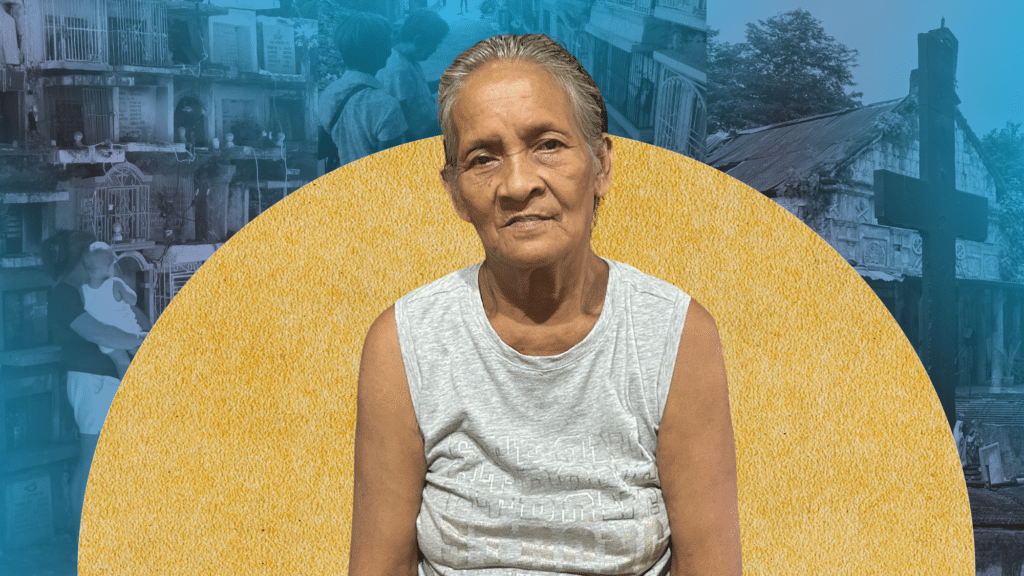CONSOLACION, Cebu— The mananabtan remains a vital figure in Cebuano Catholic tradition, especially during Kalag-Kalag.
Though some say the younger generation are less inclined to pray as fervently, the mananabtan, even in advanced age, moves forward and continues to guide families in honoring the dead, quietly preserving a ritual that has been passed down for generations.
In this article, we meet 72-year-old Nang Bening, a local mananabtan from Consolacion, Cebu, who continues the legacy of panabat in a province that is rapidly embracing modernity.
What is mananabtan?
The term mananabtan is derived from the Cebuano word sabat, which means “to repeat after.” A mananabtan is then referred to as someone who leads and recites prayers, especially long ones like novena prayers.
Buenaventurada Potestas, 72, known to her neighbors as “Nang Bening,” comes from a long line of mananabtans hailing from the mountain barangay of Manatad in the town of Sibonga, southern Cebu. She learned the craft as a child from her mother and grandmother, who sold kakanin at the local market.
Afterward, she would often join the prayers her family led in their sitio (village).
Buenaventurada Potestas, 72, mananabtan from Consolacion, Cebu. | Photo by Jessa Ngojo
“Sama nako, mamaligya og budbud, biko, mga luto, manuroy man to sila. Daghan man to’g tabo-tabo didto, mao nang maninda mi. Kuyog mi atong mama oy, maninda mi,” she says.
Like most children, Nang Bening didn’t initially embrace the task. It wasn’t until she realized she had to recite lengthy prayers—a mix of Cebuano and Latin—that the weight of the role began to sink in.
She stopped leading prayers for a time, particularly during her youth, but resumed after getting married and moving from her mountain barangay to the town where she now lives, which is in Consolacion.
“Kuan pa ko sekwentay-sinko (55)…,” Nang Bening said when asked what age she returned as a mananabtan.
When is the time to call a mananabtan?
According to Nang Bening, All Souls’ Day and All Saints’ Day keep her busy as a mananabtan, praying with families who have commissioned her to pray for their departed loved ones.
However, a mananabtan can be commissioned on days other than the Day of the Dead.
“Kanang naay mamatay, naay hugkas, kalag-kalag, mga ingun ana.”
Hugkas is a Cebuano Catholic tradition in which families commemorate the death anniversary of their departed loved ones. One way to honor their memory is through a series of prayers, which Nang Bening is often called upon to lead.
Nang Bening shared that the prayers she still uses today come exclusively from the book Novena sa mga Kalag sa Purgatoryo, which she buys from her local parish. She insists that others should follow this practice, as it was passed down to her by her mother, and she has upheld it to this day.
Does the mananabtan culture still thrive in these times?
Yes, according to Nang Bening, you may even encounter an increasing number of them, at least in her barangay in Consolacion.
Over the years, she thought she would be the only mananabtan in her sitio, but she has since noticed that a mother-and-daughter duo is also beginning to be recognized as mananabtans.
“Nidaghan. Gamay ra man to sa una kay di pa man ‘to kahibalo ang uban. Kanang iyang anak, mangadyi man na iya anak, tudluan man na niya.”
According to Nang Bening, it’s also important to pass the culture on to the younger generation, even though she has observed a decline in the number of youth attending church or participating in her panabat for families in their barangay.
“Kasagaran mga tigulang man, pero tagsa ra jud na ang mga batan-on nga musabat kay dili naman hilig ang mga bantan-on og pangadyi,” she said.
For her part, Nang Bening has been teaching her 20-year-old daughter-in-law, Eunice, the hows and dos of panabat so that she, too, could pass it on to her children in the future.
“Ako man na gitudluan gud kay nagkadako atong edad maynalang naay musunod,” she expressed.
Have a peaceful Kalag-Kalag
For this year’s Kalag-Kalag celebration, Nang Bening sends her prayers for good health and a peaceful observance.
She also reminds Cebuanos that this celebration is for our departed loved ones, who deserve our attention in the form of prayers and loving messages.
“Dapat ato gyud na sila hatagan og importansya kay adlaw na sa mga minatay.”
